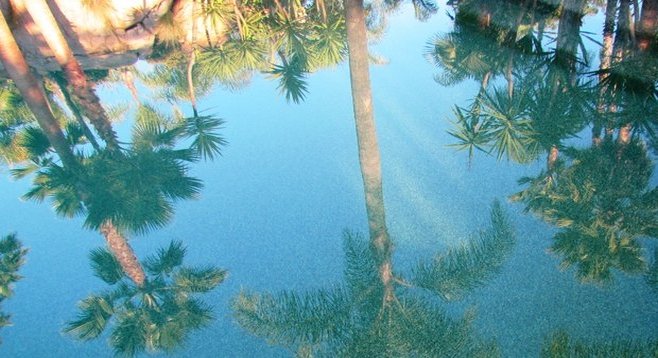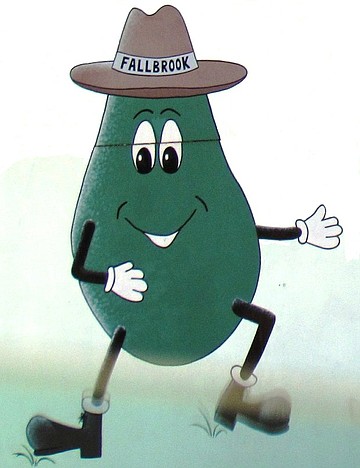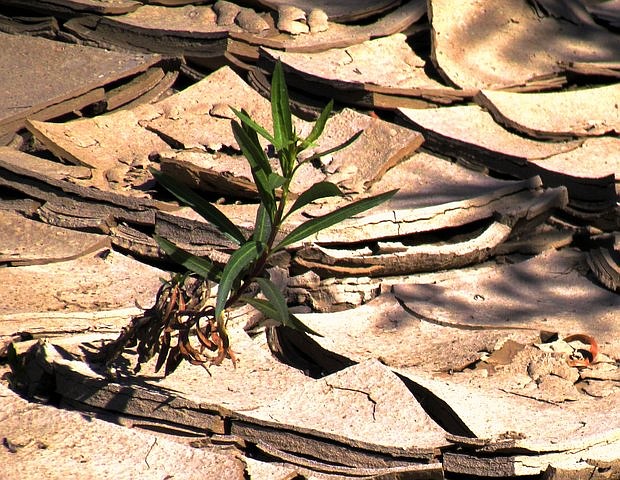 Facebook
Facebook
 X
X
 Instagram
Instagram
 TikTok
TikTok
 Youtube
Youtube


Swaying in a hammock strung beneath palm trees on a cliff side high above Rainbow Valley, a tiny village just east of the unincorporated town of Fallbrook, I look out fifteen some odd miles over hills sloped with age old groves of oak, olive and avocado trees to the horizon where Catalina Island floats in a sherbet colored sunset. The citrus trees are blooming as well as the Jasmine and I am encased in Mediterranean scented wonderfulness.
I had fallen asleep last night to the sounds of coyotes howling beneath my window and a chorus of frogs croaking in the pond behind the house. I awoke this morning to the sounds of far-off artillery.
Warriors
Camp Pendleton, the largest expeditionary training facility for military personnel on the West coast, lies just east of Fallbrook. The 125,000 acres of mostly pristine mountainous coastline—the largest undeveloped oceanfront tract in southern California -- are used to maintain combat readiness and provide specialized training programs including the Assault Amphibian School, Field Medical Service School and Marine Corps University. Just shy of 40,000 families live on base with another 30,000 living in the surrounding communities. Fallbrook, which is adjacent to the Base’s East Gate, offers those living off base a small town rural if not inland option, (in contrast to the more populated communities along the coastline). As protected as I should have felt, hearing artillery first thing in the AM was disconcerting.

Avocado Capital of the World
Self proclaimed Avocado Capital of the World, Fallbrook, California is an agricultural community of 43,000 residents. About 60,000 of its 81,000 acres, (more than 93 of its 127 square miles), are planted in avocado groves. Taking advantage of the amenable climate that enables a year round growing season and the lack of crop chomping pestilence, more than a $100 million in annual revenue from citrus, exotic nuts and fruit, flowers, and honey as well as from avocado are generated. It is very lush, very pretty hilly country.
Except, it shouldn’t be. The most southwestern county in the States, all of the 4,200 square miles of San Diego County, (which, by the way is about the same size as the state of Connecticut), are semi-arid to arid, i.e. DESERT, the Sonoran by name. Make no mistake that this IS the land of tarantulas, rattle snakes, coyotes, tortoises, roadrunners, gigantuous saguaro and prickly pear, ghost towns, tumbleweed…does any of this ring a bell?
With the cost of desalination still prohibitive, water conservation is a concern in every community on the planet. With the world’s population having tripled during the last century tapping out at almost 7 billion people today, it can hardly come as a shock that almost half of them don’t have access to a clean or otherwise adequate water supply. Yet, we are pouring drinkable water on to the parched ground every day so that we can have our OJ and extra guac slapped on our beefy burgers anytime of the year regardless of traditional growing season.

H2O on the Blue Planet
When only three percent of the water on Earth is fit for human consumption, meaning fresh versus salt, I’d think we’d be a little more conscious about how we are using it. Yet, according the U.S. Environmental Protection Agency (EPA), 80 percent of all potable water is used for irrigation, approximately 130 million gallons a day in fact mostly on farms west of the Mississippi with California being the largest consumer. Although only 16 percent of the land in active agriculture is irrigated, almost half the produce sold in the country is grown on and harvested from those acres. Therein lays the conundrum.
Both citrus and avocado trees consume in the vicinity of 40 gallons a day. With an average annual rainfall of only 16 inches, that adds up to mucho irrigation in these parts and as some of you may already know and others may have by now gathered watering a desert is highly controversial business. Adding fuel to the fire are the four golf courses located within a ten mile radius to the village center.
I don’t presume to have the answers, but I do recognize insanity when I see it and wonder how we as a people can sleep at night when our 600 liter (or 158.5 gallons) a day household consumption average is the highest of any in the world—half of which is used in outdoor applications I might add. Our consumption is six times higher than that of other developed countries and so far exceeds that of countries whose population exceeds our own that I can’t even write about it without dry heaving.
More than a decade ago, the United Nations called us to radically rethink our lifestyles, as nations, as communities, as individuals. Some did. Back in 2006, the American Water Works Association Research Foundation published data pertaining to household greywater production and the potential for reclamation and reuse, in part, as irrigation. The EPA has produced a related manual. The technology exists and local installation contractors operate in almost every community. Yet, our bad habits persist.
Greywater defined is uncontaminated wastewater resulting from bathing, dishwashing and laundry. It’s been estimated that the average U.S. household produces approximately 30,000 gallons a year (or 82 gallons a day) of greywater from their laundry facilities alone . With about 115 million households in the U.S., 3.5 quadrillion gallons a year, (or just over 9.3 trillion gallons a day), that could be used in irrigation, greatly relieving our over taxed aquifers, is wasted. And this is just from households. Imagine the gallons commercial operations such as hospitals and hotels could contribute. All that combined reclaimed water would provide ample water for irrigating farmland as well as all those golf courses. The surplus could then be flushed down the toilet, literally, guilt free.
Without government mandates, it is up to consumers and global good neighbors with an intact social conscience to make responsible choices. The upside is the fact that most laundry-to-landscape systems are presently permit exempt in San Diego County.
Arabian Oasis
In spite of the glaring reality, I have indeed landed a very sweet gig. Settled at the outdoor bistro style table set beside the pool with my plate of Trader Joe’s grilled Italian Style Vegetarian Sausage, garlic, spinach and tomatoes, and tall glass of freshly squeezed orange juice courtesy of the onsite grove, I open my book. The breeze brushes my hair across my face and I swipe it away as I look up across the property for which I have been entrusted to caretake.
These people have made an oasis from a crumbling mountain top and it truly is a beautiful retreat after a few weeks camping in four different deserts. We humans have done this--make something of nothing--since the beginning of time. And, we have long since tried to marry the practical with the aesthetic as is evident in my current surroundings.
The birds swoop down the terraced waterfall in search of bugs. Succulents including massive hedges of jade, aromatic bushes of sage, rosemary and lavender, as well as exotic Birds of Paradise and a plethora of other flowers grow between the boulder embedded hillside. I am soothed by the sounds of water trickling and breezes brushing through palm fronds, and of birdsong.
There is some evidence that this hilltop and the valley below was ravaged by Santa Anna swept wildfires back in 2007, but in the three years since, much is recovered and greenery sprouts from the charred earth. Life is on the rebound.
But, these are conscious, cautious folks. The succulent ground cover and plants, the jade hedges all provide excellent fire prevention. A series of rain barrels collect the rain that does fall in these parts, which they then use to augment the irrigation of their orchards and gardens. Here, there are compost and recycling bins, as well as solar panels. The freezer and pantry is jammed with food grown on site. One does what one can.
The dog is nudging me in impatience. Hours had transpired without my awareness--easy to do in a peaceful sanctuary like the one they've created here on this hilltop. I pull myself away from Nicholas Sparks and the bottle of Valentin Shiraz they left me to go fill his bowl with food and administer his nightly medicine.
I’ll be in this private tropical haven for another two weeks I remind myself as I slide my feet back into my flip flops. I plan on enjoying every minute.



Swaying in a hammock strung beneath palm trees on a cliff side high above Rainbow Valley, a tiny village just east of the unincorporated town of Fallbrook, I look out fifteen some odd miles over hills sloped with age old groves of oak, olive and avocado trees to the horizon where Catalina Island floats in a sherbet colored sunset. The citrus trees are blooming as well as the Jasmine and I am encased in Mediterranean scented wonderfulness.
I had fallen asleep last night to the sounds of coyotes howling beneath my window and a chorus of frogs croaking in the pond behind the house. I awoke this morning to the sounds of far-off artillery.
Warriors
Camp Pendleton, the largest expeditionary training facility for military personnel on the West coast, lies just east of Fallbrook. The 125,000 acres of mostly pristine mountainous coastline—the largest undeveloped oceanfront tract in southern California -- are used to maintain combat readiness and provide specialized training programs including the Assault Amphibian School, Field Medical Service School and Marine Corps University. Just shy of 40,000 families live on base with another 30,000 living in the surrounding communities. Fallbrook, which is adjacent to the Base’s East Gate, offers those living off base a small town rural if not inland option, (in contrast to the more populated communities along the coastline). As protected as I should have felt, hearing artillery first thing in the AM was disconcerting.

Avocado Capital of the World
Self proclaimed Avocado Capital of the World, Fallbrook, California is an agricultural community of 43,000 residents. About 60,000 of its 81,000 acres, (more than 93 of its 127 square miles), are planted in avocado groves. Taking advantage of the amenable climate that enables a year round growing season and the lack of crop chomping pestilence, more than a $100 million in annual revenue from citrus, exotic nuts and fruit, flowers, and honey as well as from avocado are generated. It is very lush, very pretty hilly country.
Except, it shouldn’t be. The most southwestern county in the States, all of the 4,200 square miles of San Diego County, (which, by the way is about the same size as the state of Connecticut), are semi-arid to arid, i.e. DESERT, the Sonoran by name. Make no mistake that this IS the land of tarantulas, rattle snakes, coyotes, tortoises, roadrunners, gigantuous saguaro and prickly pear, ghost towns, tumbleweed…does any of this ring a bell?
With the cost of desalination still prohibitive, water conservation is a concern in every community on the planet. With the world’s population having tripled during the last century tapping out at almost 7 billion people today, it can hardly come as a shock that almost half of them don’t have access to a clean or otherwise adequate water supply. Yet, we are pouring drinkable water on to the parched ground every day so that we can have our OJ and extra guac slapped on our beefy burgers anytime of the year regardless of traditional growing season.

H2O on the Blue Planet
When only three percent of the water on Earth is fit for human consumption, meaning fresh versus salt, I’d think we’d be a little more conscious about how we are using it. Yet, according the U.S. Environmental Protection Agency (EPA), 80 percent of all potable water is used for irrigation, approximately 130 million gallons a day in fact mostly on farms west of the Mississippi with California being the largest consumer. Although only 16 percent of the land in active agriculture is irrigated, almost half the produce sold in the country is grown on and harvested from those acres. Therein lays the conundrum.
Both citrus and avocado trees consume in the vicinity of 40 gallons a day. With an average annual rainfall of only 16 inches, that adds up to mucho irrigation in these parts and as some of you may already know and others may have by now gathered watering a desert is highly controversial business. Adding fuel to the fire are the four golf courses located within a ten mile radius to the village center.
I don’t presume to have the answers, but I do recognize insanity when I see it and wonder how we as a people can sleep at night when our 600 liter (or 158.5 gallons) a day household consumption average is the highest of any in the world—half of which is used in outdoor applications I might add. Our consumption is six times higher than that of other developed countries and so far exceeds that of countries whose population exceeds our own that I can’t even write about it without dry heaving.
More than a decade ago, the United Nations called us to radically rethink our lifestyles, as nations, as communities, as individuals. Some did. Back in 2006, the American Water Works Association Research Foundation published data pertaining to household greywater production and the potential for reclamation and reuse, in part, as irrigation. The EPA has produced a related manual. The technology exists and local installation contractors operate in almost every community. Yet, our bad habits persist.
Greywater defined is uncontaminated wastewater resulting from bathing, dishwashing and laundry. It’s been estimated that the average U.S. household produces approximately 30,000 gallons a year (or 82 gallons a day) of greywater from their laundry facilities alone . With about 115 million households in the U.S., 3.5 quadrillion gallons a year, (or just over 9.3 trillion gallons a day), that could be used in irrigation, greatly relieving our over taxed aquifers, is wasted. And this is just from households. Imagine the gallons commercial operations such as hospitals and hotels could contribute. All that combined reclaimed water would provide ample water for irrigating farmland as well as all those golf courses. The surplus could then be flushed down the toilet, literally, guilt free.
Without government mandates, it is up to consumers and global good neighbors with an intact social conscience to make responsible choices. The upside is the fact that most laundry-to-landscape systems are presently permit exempt in San Diego County.
Arabian Oasis
In spite of the glaring reality, I have indeed landed a very sweet gig. Settled at the outdoor bistro style table set beside the pool with my plate of Trader Joe’s grilled Italian Style Vegetarian Sausage, garlic, spinach and tomatoes, and tall glass of freshly squeezed orange juice courtesy of the onsite grove, I open my book. The breeze brushes my hair across my face and I swipe it away as I look up across the property for which I have been entrusted to caretake.
These people have made an oasis from a crumbling mountain top and it truly is a beautiful retreat after a few weeks camping in four different deserts. We humans have done this--make something of nothing--since the beginning of time. And, we have long since tried to marry the practical with the aesthetic as is evident in my current surroundings.
The birds swoop down the terraced waterfall in search of bugs. Succulents including massive hedges of jade, aromatic bushes of sage, rosemary and lavender, as well as exotic Birds of Paradise and a plethora of other flowers grow between the boulder embedded hillside. I am soothed by the sounds of water trickling and breezes brushing through palm fronds, and of birdsong.
There is some evidence that this hilltop and the valley below was ravaged by Santa Anna swept wildfires back in 2007, but in the three years since, much is recovered and greenery sprouts from the charred earth. Life is on the rebound.
But, these are conscious, cautious folks. The succulent ground cover and plants, the jade hedges all provide excellent fire prevention. A series of rain barrels collect the rain that does fall in these parts, which they then use to augment the irrigation of their orchards and gardens. Here, there are compost and recycling bins, as well as solar panels. The freezer and pantry is jammed with food grown on site. One does what one can.
The dog is nudging me in impatience. Hours had transpired without my awareness--easy to do in a peaceful sanctuary like the one they've created here on this hilltop. I pull myself away from Nicholas Sparks and the bottle of Valentin Shiraz they left me to go fill his bowl with food and administer his nightly medicine.
I’ll be in this private tropical haven for another two weeks I remind myself as I slide my feet back into my flip flops. I plan on enjoying every minute.
Comments